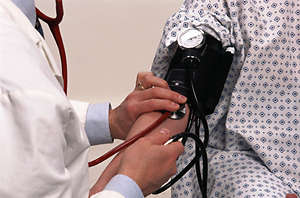
 |
|
 High blood pressure is sometimes referred to as hypertension. It's defined as persistent elevated blood pressure readings exceeding 140/90 in adults with blood pressure indicating the stress placed on the walls of the arteries, the veins, and the heart chambers by the flow of blood. Blood pressure is measured by the use of a blood pressure cuff and a stethoscope. Two measurements are utilized for a blood pressure reading. The first number measures the (systolic pressure), which indicates the pressure in your arteries while your heart beats. The second number measures the (diastolic pressure), which indicates the pressure while your heart rests between beats. Systolic 140 Diastolic 90 Normal blood pressure falls within a range and is not just one set of numbers. If your an adult, normal blood pressure should be less than 140/90. The following is a guide to various classifications of blood pressure for both diastolic and systolic. Diastolic Blood Pressure
Systolic Blood Pressure
High blood pressure is often referred to as the "Silent Killer" since symptoms are virtually non-existent and those afflicted may already suffer from damaged body organs before they know it. Individuals with high blood pressure are:
High blood pressure can not be cured, but it can be controlled. Awareness is key. Have your blood pressure checked as part of a routine health screening. These tests are quick and painless and can be performed in a doctor's office, hospital, school or company clinic, and at many health fairs. Uncontrollable Factors
Controllable Factors
Reducing the controllable factors may significantly decrease your chances of becoming afflicted with high blood pressure. Check with your health care provider. Maintain regular checkups and stay informed. |
|
Office Hours: Mon-Thurs 8 a.m. - 8 p.m. Friday 8 a.m. - 4 p.m. Saturday 8 a.m. - 2 p.m. |